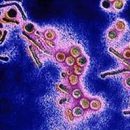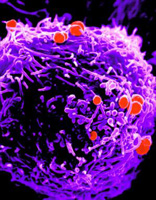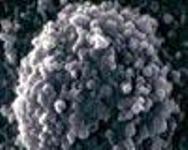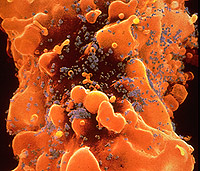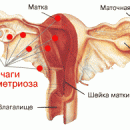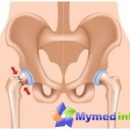Toxoplasmosis is a parasitic disease in which the nervous system, eyes, muscles, lymph nodes, liver and spleen affect.
Content
Toxoplasmosis is a parasitic disease, characterized by damage to the nervous system, eye, skeletal muscles and muscles of the heart, as well as an increase in lymph nodes, liver and spleen. Prone to chronic flow.
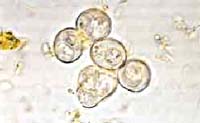
Pathogene - Toxoplasma Gondii - an intracellular parasite related to the simplest. Its final owner is a homemade cat, emitting with toxoplasm facilities, which are capable of long (up to 2 years) to persist in an external environment and infect many species of animals and humans. Other animals serve as intermediate owners. A person's infection occurs when in contact with feline feces, with earth and sand contaminated with them, as well as when testing the meat minced meat or consuming, not suckling meat. Lady and pork very often contain toxoplasm (from 10 to 25%). Contact with dogs, agricultural animals to infectness people do not lead. Sick man for others do not contagious.
The transfer of toxoplasm is also possible when transplanting organs of infected donors, and with intrauterine infection of the fetus from the mother through the placenta. Accordingly, the method of infection is distinguished by congenital and acquired toxoplasmosis.
The gates of infection are the digestive organs, toxoplasms are introduced into the small intestine and reach its lymph nodes, where they breed, causing inflammation. The parasites are then falling into the blood and spread throughout the body and «settle» In various organs and tissues: liver, spleen and lymph nodes, there they are sometimes saved for life. The protective forces of the body in most cases prevent the development of the disease, however, when they are weakened, it develops. The disease may occur in 10-20 years after infection.
Most infected people have no clinical manifestations of the disease. Part of the patients has sluggish chronic forms and is extremely rare - sharp, with severe disease. With intrauterine infection in the first months of pregnancy often there is a miscarriage and fetal death. The possibility of intrauterine deformities of the fetus and birth of children with development defects. If the infection occurred at the later period of pregnancy, a child is born with generalized toxoplasmosis.
Manifestations of acquired toxoplasmosis
In most infected toxoplasms, clinical manifestations are absent, but the part of the infected in 2-3 weeks - a sharp acquired toxoplasmosis is formed for several months. As a rule, acute acquired toxoplasmosis begins gradually. At the same time, patients cannot accurately indicate the beginning of the disease.
The main complaints of patients are increased fatigue, reduction of working capacity, weakness, cognition, increase in temperature to 38.5°C, there may be a small headache, pain in the muscles and joints.
By the end of 2-3 weeks of the disease, the patients appear an increase in lymph nodes (insignificant, up to 2 cm in diameter), nodes are moderately painful or painless when feeling. More often than others there is an increase in the rear, cervical, less often armpit, over- and plug-in and very rarely inguinal lymph nodes. Most patients with acute acquired toxoplasmosis marks an increase in liver. The spleen increases less.
Manifestations chronic acquired toxoplasmosisbut
The most common form of toxoplasmosis. For chronic purchased toxoplasmosis, a long-term increase in body temperature is characterized up to 37.2 - 37.6O C, which is not treated with ordinary means. The defeat of the central nervous system is manifested in the form of sluggish encephalitis, arachnoiditis, vegetative-vascular disorders, manifested by headaches, a deterioration in memory, a decrease in interest in the surrounding, impaired sleep, adamisia, weakness, various fears, obsessic states. At the same time, patients complain of a permanent increase in general weakness, fast fatigue, decline in appetite, no feeling of cheerfulness after sleeping. They become irritable, in the evening they can't sleep for a long time, they wake up at night, and in the morning they are bothering and bad mood. They are often bothering a stupid headache, pain in the joints and muscles. There is an increased sensitivity to sound and light stimuli, unsustainable mood, intolerance. In chronic toxoplasmosis, the lesion of lymph nodes is characterized, the increase in liver and spleen. This often increases the rear, cervical, axillary and inguinal lymph nodes. The damage to the cardiovascular system is associated with the damage to the heart muscle and manifests itself with heartbeats, compressing and goded pain in the heart area, rhythm disorders, decrease in blood pressure. The lesion of the gastrointestinal tract is manifested by dry mouth, a decrease in appetite, stupid pain in the stomach, bloating and gases delay.
Endocrine disorders are characterized by disorders of the menstrual cycle in women, impotence in men, pancreatic lesions. Some women have the usual non-leaving of pregnancy. Violation of the organ of vision can be in the form of chorioretinites, uveitis, progressive myopia.
The lesion of the musculoskeletal system is associated with the preferably muscle defeat and manifests them with pain in the muscles of the legs, hips, loins, less often - in the muscles of the back, neck, hands. Sometimes muscle pain is so strong that make it difficult to move.
Manifestations BBorn toxoplasmosisbut
 Congenital toxoplasmosis - diseases of children arising from infection during intrauterine development. Fruit infection from the mother occurs only in the case of acute infection of the woman during this pregnancy, when the pathogen with blood can get into the placenta. It is formed a focus of infection, from where the toxoplasms with blood flow fall to the fetus. In women infected with toxoplasmosis to pregnancy (chronic or latent infection), the transmission of the pathogen into the fruit is not proven, since the Mother's immune system protects the fetus from infection.
Congenital toxoplasmosis - diseases of children arising from infection during intrauterine development. Fruit infection from the mother occurs only in the case of acute infection of the woman during this pregnancy, when the pathogen with blood can get into the placenta. It is formed a focus of infection, from where the toxoplasms with blood flow fall to the fetus. In women infected with toxoplasmosis to pregnancy (chronic or latent infection), the transmission of the pathogen into the fruit is not proven, since the Mother's immune system protects the fetus from infection.
The severity of clinical manifestations depends on the time of intrauterine infection of the fetus. If this happens in the first trimester of pregnancy (in this case, the infection of the fetus is possible in 15-30% of cases) at the birth of a child formed chronic congenital toxoplasmosis with severe lesions in the form of a brain, microcephaly, chorioretinite, microfthalma, landmarks in the brain, backlog in Psychomotor Development. Usually this pregnancy ends with miscarriage. Do not try to preserve this pregnancy, since therapeutic measures in children with chronic congenital toxoplasmosis practically do not bring a positive result.
When infected with a pregnant woman in the IIth trimester (the infection of the fetus is observed in 25% of cases) the newborn is formed by a subacute congenital toxoplasmosis. In such cases, the central nervous system is affected most often - encephalitis (inflammation of the brain) is developing (inflammation of the brain), the defeat of the brain-brain nerves, sluggish paralysis and paresis, chorioretinitis with the formation of subsequent blindness. With timely diagnosis, chemotherapy is shown in the newborn breeding congenital toxoplasmosis.
When pregnant in the third trimester (fetal infection occurs in 65-70% of cases) is formed acute congenital toxoplasmosis, which is manifested by fever, increased excitability, an increase in lymph nodes, lack of appetite, rash, increased liver and spleen, cardiovascular lesion Vascular system (myocardits). If the fruit did not die, then the signs of the disease are visible immediately after birth: common rashes on the skin, high temperature, liver damage, encephalitis, brain leaning, eye damage. The disease can progress and end the child's death in the first weeks of life or go into a chronic form. This marks the delay in the development of the child, primarily the mental. Can develop dementia, the development of speech is disturbed. There is a slowdown in physical development: children eat badly, behind the growth. They can develop impairment.
Sometimes congenital toxoplasmosis can manifest itself aged 10-15 years.
Diagnosis of toxoplasmosis
Toxoplasmosis should be suspected in cases of a long-term increasing body temperature. The diagnosis is confirmed by special blood tests - the identification of antibodies in the blood-specific for toxoplasmosis. The most sensitive and specific method of diagnosis of toxoplasmosis is an immunoassimensional analysis (IFA), T.E. Igm and IgG IGM Class Antibodies to Toxoplasmas.
Toxoplasmosis surveys are subject to:
- In compulsory, all pregnant women in the greatest period of pregnancy (ideally - before it);
- Women suffering from infertility and dispublinking pregnancy (miscarriage in the period of up to 12 weeks).
Treatment of toxoplasmosis
In acute toxoplasmosis, chemotherapeutic drugs are used, antibiotics. Treatment of chronic toxoplasmosis is many times more difficult than acute, since the chemotherapy does not have a significant effect. The main place is occupied by hyposensitizing and immunomodulatory therapy. The complex of treatment includes vitamins, desensitizing agents, lidase, cerebrolysin, etc.
There are data on the positive effect of levamizol in chronic toxoplasmosis therapy. Levamizol is prescribed 150 mg 3 days in a row with interruptions of 1 weeks between cycles, only 2 - 3 cycles.
Prevention of toxoplasmosis
The prevention of infection with toxoplasmas is to eat only well thermally processed meat and meat products, purely washed vegetables, fruits and berries. In the process of cooking, it is forbidden to try the taste of raw meat minced meat. It is necessary to thoroughly wash your hands after processing raw meat products, work in the garden, garden, children after playing in the playground and, especially in the sandbox. Sanitary and hygienic rules of content in the apartment of domestic animals should be carefully observed, not forgetting to wash your hands after contacts with them.
At the occurrence of pregnancy, each woman should be examined for toxoplasmosis in women's consultation. When detecting clinical manifestations of toxoplasmosis in pregnant clinical manifestations, as well as the detection of antibodies to Class IGM toxoplasms, the need to treat or interrupt pregnancy should be resolved.


